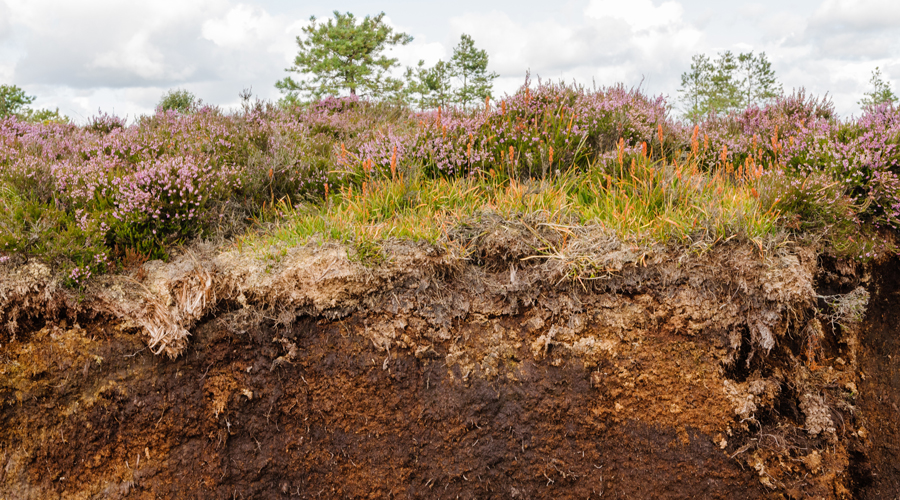Despite looking like wastelands, peatlands are incredibly useful, and need to be protected. What’s so special about these peat bogs? If we stop taking peat what can we do to replace the roles that peat serves?
Take a moment to think about the fight against climate change. In your head you may be conjuring up pictures of swapping gas-guzzling cars for bicycles and electric cars, perhaps thoughts on shifting coal fired power stations to make way for windfarms and solar panels, you may even have thought about reversing deforestation of the Amazon and other rainforests.
But in your mind, were any of those images related to the role of peatlands?

Cross-section of a peat bog showing heather and plants on top
Peat is formed through a process of gradual accumulation of the remains of plants in a wet environment. This oxygen-restrictive environment prevents full plant decomposition because the bacteria and fungi that cause decay cannot do so in lower oxygen levels. The carbon dioxide absorbed by plants when they were alive is therefore stored in the ground, and not released back into the atmosphere.
These peatlands can be incredibly ancient, with remains that have slowly built up over many hundreds, possibly thousands of years. It is also thought that it can even take up to ten years for 1 cm of peat to form. Some areas of peatland are several metres deep.
As a form of storage of carbon, it is almost impossible to understate the importance of peatlands. For example, in Europe peatlands hold more than five times the amount of carbon that is stored in all the forests. Worldwide peatlands contain more than 550 gigatonnes of carbon, twice that absorbed by the world’s trees, whilst only making up 3% of the total land surface.
There is evidence of humans utilising peat for centuries, but problems only began to arise relatively recently, when the scale of excavation increased dramatically. Governments across the globe co-ordinated large-scale operations for peatland use. This began in the 1930s, with the peatland used for farms, and large scale burning of the carbon rich peaty soil as fuel for warmth, and eventually to produce electricity. This was especially bad for the environment, as peat releases more carbon dioxide and less heat when compared to coal burning. In other words, peat burning is less efficient than coal at transferring heat and produces more carbon dioxide.
Eventually it was found that peat could be useful in horticulture. Peat provided a rich medium for growing plants. It is high in nutrients and has attractive properties for greenhouse growers. By the 1960s, large scale commercial peat extraction for horticulture kicked-off, and by 1999, peat made up a staggering 94% of all British growing media. This process has led to the loss of up to Ninety-five percent of England’s bogs in the last hundred years.
As time went on, the environmental impacts of peat excavation became more apparent. Peat systems can be quite fragile to disturbance. For example, when peat becomes open through digging and does not have a layer of live plants growing on top, exposure leads to peatland drying, causing changes in the vegetation. The carbon that was trapped in the peat leaves in the form of carbon dioxide, putting more greenhouse gas in the atmosphere and adding to man-made climate change.
There has been global acknowledgement that peat extraction is environmentally damaging and unsustainable, which has led to massive efforts to reduce the use of peat each year in our gardens and greenhouses. Peat use is half what it was in 1999 levels and the target is to have no peat after 2030.
Currently peat is still popular within the UK for gardeners and professional growers, with approximately 1 million cubic metres of peat used each year. As the peatlands continue to disappear, it is becoming more and more urgent for alternatives of peat to be found and taken up by amateurs and professional gardeners alike.
People have tried many alternatives to using peat for growing plants. Some substances that have been swapped for peat are:
- coconut shell dust
- farm animal manure
- composts made of plants and mushrooms
- bark
- sewage sludge and much more.
The difficulty in replacing peat is the need to have the perfect physical, chemical and biological properties for root development. The properties plant scientists need to consider are:
- Physical – does it hold the right amount of water? Is it the right density for roots to grow easily through it?
- Chemical – does it have the right level of nutrients? Could there be anything toxic to the plant in the medium?
- Biological – does the medium promote the right kind of microbe growth? Does it attract dangerous pathogens, weeds and pests?
Many of these tests are still underway, and even when scientists prove the success of any of these materials in theory, growers have been reporting disappointing results in practice.
The challenge now is trying to find more suitable peat replacements that can end peat use once and for all. For example, my PhD project aims to test the success of peat alternatives in the growing of British lettuce, an important crop for shops and supermarkets. With a specific focus on how root development may be impacted and devising strategies to combat these changes.
The urgency for action to help against climate change may have already persuaded you to reduce your own carbon footprint, from swapping the car journey into school for a bike ride, to putting on a jumper instead of turning up the heating. Whilst these steps are useful for combating global warming, take a moment to appreciate the efforts of the world’s peat bogs, and perhaps check for the ‘peat free’ label the next time your family buys compost for the garden.
Download PDF
If you wish to save, or print, this article please use this pdf version »
Learning resource
We have created learning notes to assist students and educators to further investigate the topics covered in this article. You can download the learning resource here »


